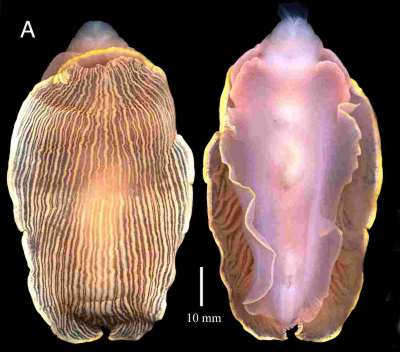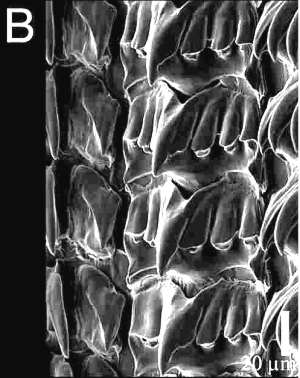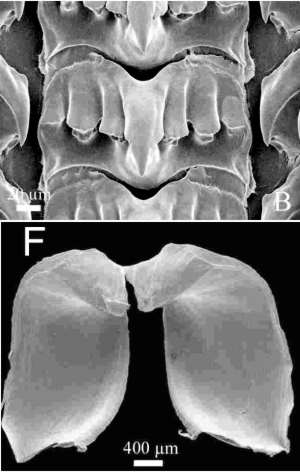Armina muelleri
(von Ihering, 1886)
Order: NUDIBRANCHIA
Suborder: ARMININA
Family: Arminidae
DISTRIBUTION
Reported from southern Brazil [Florianopolis to Sao Paulo]. May have a wider distribution to the Caribbean.
Originally described from Florianopolis in southern Brazil (v. Ihering, 1886), but identity still problematic. Like many species of Armina the animal was described as dark, almost black, with light yellow or pale reddish ridges on the mantle. Ihering described the lateral radula teeth as being smooth, lacking denticles. Marcus & Marcus (1970) identify animals from Sao Paulo with this species and describe a radula in which the first lateral teeth ocasionally has one outer denticle, and the other lateral teeth can have up to 4 outer denticles. They also consider specimens from Surinam, (Njissen-Meyer, 1965) identified as A. semperi, to be A. muelleri. If this identfication is correct, it would increase the range of the species into the Caribbean.
See Néstor Ardila's message [#12433] suggesting that Armina abbotti is a synonym.
References:
• Ihering, H. v. 1886a. Zur Kenntniss der Nudibranchien der brasilianischen Kuste. Jahrbucher der Deutsche Malakozoologische Gesellschaft 13(3): 223-240, pl. 9.
• Marcus, Ev. & Marcus, Er. (1960) Opisthobranchs from American Atlantic warm waters. Bulletin of Marine Science of the Gulf and Caribbean, 10(2): 129-203.
• Marcus, E. & Marcus, E (1967) Tropical American opisthobranchs. Studies of Tropical Oceanography, 6: 3-137.
Rudman, W.B., 2004 (March 15) Armina muelleri (von Ihering, 1886). [In] Sea Slug Forum. Australian Museum, Sydney. Available from http://www.seaslugforum.net/find/armimuel
Related messages
Armina abbotti = A. muelleri?
March 17, 2004
From: Néstor E. Ardila

Dear Bill,
According to a revision in progress of the species of Armina from southern Caribbean (Ardila & Valdés - in evaluation) Armina abbotti Thompson, Cattaneo & Wong, 1990 is regarded as a synonym of A. muelleri . I am sure that Kelly Hooper´s photo [#12385] is Armina muelleri. I send photos of Colombian material to compare.
Reference:
• Ardila, N. E. & A. Valdés (in evaluation). The genus Armina (Gastropoda: Nudibranchia: Arminidae) in the Southern Caribbean, with the description of a new species.
Best regards,
Néstor E. Ardila
nardila@invemar.org.co


Thanks Néstor,
I look forward to seeing this review when it is published. It would certainly make sense to have one common species from South Carolina to Brazil. However I guess it's best to leave the species A. abbotti until your revision is published. Black or dark reddish bodies and white or yellow edged mantle ridges seem to be almost a generic character in this family, so colour alone needs to be treated cautiously. For example your recently described Armina juliana is almost identical in colour. I know that that species has fewer mantle ridges and a different radular morphology, but I wonder whether these characters also need to be re-evaluated. The problem is that we have no idea whether there are morphological changes within a species as it grows from juvenile to adult. For example, perhaps juveniles begin with a few sparsely arranged longitudinal ridges on the mantle, and as they grow more ridges develop to fill the spaces?
And we know nothing of ontogenetic changes in radular morphology. A good example is found in Tritonia hombergi where the juvenile tooth is so different from that of adults that it was considered a separate species. We see in species of arminids, that some have a central tooth reminsiscent of that of juvenile T. hombergi and others have a tooth similar to that of adult T. hombergi. Perhaps something similar to the ontogenetic changes that occur in some tritoniids also occur in some arminids?
On a more specific level, Ihering described the lateral tooth of A. muelleri as smooth, while Marcus & Marcus (1970) say that there can be a single outer denticle on the innermost lateral tooth, and up to four on the other lateral teeth. In your SEM photo I can see the single denticle, described by Marcus & Marcus, on the innermost lateral tooth. If you compare this with the radula illustrated by Eyster (1981) from South Carolina [as A. tigrina] then the denticulation on the first lateral teeth is quite different. The outer denticles are not a few fine spine-like projections but heavy triangular 'teeth' covering the whole outer edge of the tooth. She describes up to 7 of these denticles. I would think this is a significantly different structure to the teeth in your animals.
However before decisions can be made, I would think we need to have a better understanding on just how variable the tooth morphology, and other characters are in these animals. Unfortunately most studies have been based on a very few specimens from widely separated localities. What needs to be done is comprehensive studies of single populations so the researcher can see colour variability first hand, can see external anatomical features like the shape of the rhinophores and oral veil caruncles before they are preserved and mishapen, and can watch for ontogenetic changes as the animals mature.
• Eyster, L.S. (1981) Observations on the growth, reproduction and feeding of the nudibranch Armina tigrina. J. Moll. Stud., 47: 171-181.
• Marcus, Ev. & Marcus, Er. (1960) Opisthobranchs from American Atlantic warm waters. Bulletin of Marine Science of the Gulf and Caribbean, 10(2): 129-203.
Best wishes
Bill Rudman
